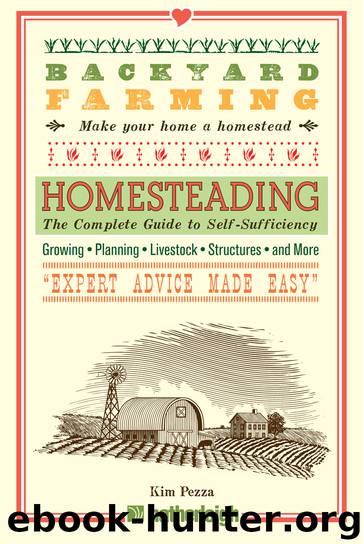Homesteading: The Complete Guide to Self-Sufficiency by Kim Pezza

Author:Kim Pezza [Pezza, Kim]
Language: eng
Format: epub
ISBN: 978-1-57826-599-2
Publisher: Hatherleigh Press
Published: 2018-03-19T16:00:00+00:00
What to Grow
Now that you have decided which method (or methods) you will be using for your garden, and have made the decision of going organic (or not), it is time to determine what will be in your garden. Of course, you probably already have your wish list, but this is the time for realistic decisions. Keep in mind how much space you really have, and how much time you have to dedicate to your garden at this time. If you are a new gardener, you may be more comfortable starting with some easier vegetables and herbs. Tomatoes, cucumbers, leaf lettuce and most basic herbs are examples of plants that are great for the first time gardener, as are strawberries, blueberries and the ever prolific zucchini. Although it is just as easy to begin from seed with most of these plants, the beginning gardener may be more comfortable starting with seedlings or young plants.
When selecting your plants, remember that there are four types:
Annuals: Plants that come up for one year or season only, and must be replaced the following year (although, if allowed to go to seed, you could get new plants the following year). Most annuals will die off completely at the first hard or killing frost. Most vegetables fall under this category, especially for those who live in areas with four seasons.
Biannuals: Plants that will go to seed the second year. Onions, carrots and beets, left in their natural state, fall under this category.
Perennials: Plants that will come back year to year. Many edible flowers and herbs fall under this category, as well as vegetables such as asparagus. Many berries and all fruit trees are perennials.
Tender Perennials: Plants that are grown as perennials in mild climates but as annuals in colder climates, due to the fact that they cannot survive the extreme cold and snow. Some good examples include rosemary and French tarragon.
Download
This site does not store any files on its server. We only index and link to content provided by other sites. Please contact the content providers to delete copyright contents if any and email us, we'll remove relevant links or contents immediately.
Turbulence by E. J. Noyes(7980)
The Thirst by Nesbo Jo(6881)
Gerald's Game by Stephen King(4610)
Be in a Treehouse by Pete Nelson(3997)
Marijuana Grower's Handbook by Ed Rosenthal(3643)
The Sprouting Book by Ann Wigmore(3561)
The Red Files by Lee Winter(3392)
The Remains of the Day by Kazuo Ishiguro(3348)
Sharp Objects: A Novel by Gillian Flynn(2985)
Christian (The Protectors Book 1) by L. Ann Marie(2669)
Organic Mushroom Farming and Mycoremediation by Tradd Cotter(2661)
The Culinary Herbal by Susan Belsinger(2453)
Stone Building by Kevin Gardner(2374)
The Starter Garden Handbook by Alice Mary Alvrez(2308)
Lilac Girls by Martha Hall Kelly(2273)
The Unlikely Pilgrimage of Harold Fry by Rachel Joyce(2242)
The Lean Farm Guide to Growing Vegetables: More In-Depth Lean Techniques for Efficient Organic Production by Ben Hartman(2107)
Urban Farming by Thomas Fox(2083)
Backyard Woodland by Josh VanBrakle(1910)
